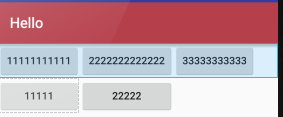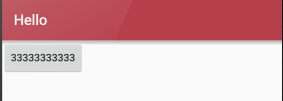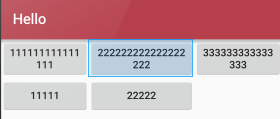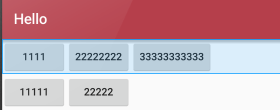第八章 android-布局
常用的布局实现方式:线性布局,框架布局,表格布局,相对布局,绝对布局
1,线性布局
(1)线性布局是一种很重要的布局,也是经常用到的一种布局
(2)在线性布局中,所有的元素都按照水平竖直的顺序在界面上排序
如果水平排序,则每行包含一个界面元素
如果垂直排序,则每列只包含一个元素

(3)线性布局常用的常用属性:
android:orientation=“vertical”(该属性决定了他的子控件的布局方式)】
android:gravity=“center”(该属性决定了他的子类的xy位置)
常用到的几个属性值:
center_vertical:垂直(y轴)居中)
center_horizontal:水平(x轴)居中
centrer:水平垂直都居中
right:子类控件位于当前布局的右边
left:子类控件位于当前布局的左边
bottom:子类控件位于当前布局的下面
(4)代码操作过程
1)首先为了能完整的体验创建线性布局的过程,首先删除自动建立的res/layout/main.xml文件,然后建立用于显示垂直排列的线性布局的XML文件
2)右键--->xml--->LayoutXML File打开新文件建立向导
3)文件名为:main_vertical.xml
4)保存位置为res/layout
5)双击建立的
关键代码:
横向:
android:orientation="horizontal"
纵向:
android:orientation="vertical"
完整代码:
(1)纵向布局
<?xml version="1.0" encoding="utf-8"?>
<LinearLayout xmlns:android="http://schemas.android.com/apk/res/android"
android:orientation="vertical" android:layout_width="match_parent"
android:layout_height="match_parent"
android:stretchColumns="*"
android:id="@+id/Tablelayout01">
<TextView
android:id="@+id/tv"
android:layout_width="match_parent"
android:layout_height="wrap_content"
android:textSize="40dp"
android:text="hello"/> <Button
android:id="@+id/btn"
android:layout_width="wrap_content"
android:layout_height="wrap_content"
android:text="button1"
/>
<Button
android:id="@+id/btn3"
android:layout_width="wrap_content"
android:layout_height="wrap_content"
android:text="button2"
/> <Button
android:id="@+id/btn2"
android:layout_width="wrap_content"
android:layout_height="wrap_content"
android:layout_x="150dp"
android:layout_y="120dp"
android:text="button3"
/> </LinearLayout>

(2)横向布局
完整代码
<?xml version="1.0" encoding="utf-8"?>
<LinearLayout xmlns:android="http://schemas.android.com/apk/res/android"
android:orientation="horizontal" android:layout_width="match_parent"
android:layout_height="match_parent"
android:stretchColumns="*"
android:id="@+id/Tablelayout01">
<TextView
android:id="@+id/tv"
android:layout_width="wrap_content"
android:layout_height="wrap_content"
android:textSize="40dp"
android:text="hello"/> <Button
android:id="@+id/btn"
android:layout_width="wrap_content"
android:layout_height="wrap_content"
android:text="button1"
/>
<Button
android:id="@+id/btn3"
android:layout_width="wrap_content"
android:layout_height="wrap_content"
android:text="button2"
/> <Button
android:id="@+id/btn2"
android:layout_width="wrap_content"
android:layout_height="wrap_content"
android:layout_x="150dp"
android:layout_y="120dp"
android:text="button3"
/> </LinearLayout>
效果:

2,框架布局
http://www.cnblogs.com/excellencesy/p/9051441.html
3,表格布局
(1)表格布局也是一种常用的界面布局,它将屏幕划分网络,通过指定行和列可以将界面元素添加到网格中
1)网格的边界对用户是不可见的
2)表格布局还支持嵌套,可以将另一个表格布局放置在前一个表格布局的网格中,也可以在表格不居中添加其他的界面布局,例如:线性布局,相对布局等等
(2)表格布局的注意事项
1)向界面中添加一个表格布局,无需修改布局的属性值。其中,id属性为TableLayout01.layout Width 和Layout height属性都是wrap_content
2)向TableLayout中添加一个表格布局,无需修改布局的属相值。其中为
A隐藏从0 开始的索引列:
android:collapseColumns="0,1"


B收缩从零开始的索引列:
android:shrinkColumns="0,2,1"


C拉伸从另开始的索引列:
android:stretchColumns="0"


(3) 实例

<?xml version="1.0" encoding="utf-8"?>
<TableLayout xmlns:android="http://schemas.android.com/apk/res/android"
android:orientation="vertical" android:layout_width="match_parent"
android:layout_height="match_parent"
android:stretchColumns="*"
android:id="@+id/Tablelayout01">
<TextView android:id="@+id/tv"
android:text="90"
android:textSize="40dp"
android:gravity="right"
android:layout_width="match_parent"
android:layout_height="50dp"/>
<TableRow android:id="@+id/tableroe01"
android:layout_width="wrap_content"
android:layout_height="wrap_content">
<Button android:id="@+id/bt1"
android:text="1"
android:layout_width="wrap_content"
android:layout_height="wrap_content"/>
<Button android:id="@+id/bt2"
android:text="2"
android:layout_width="wrap_content"
android:layout_height="wrap_content"/>
<Button android:id="@+id/bt3"
android:text="3"
android:layout_width="wrap_content"
android:layout_height="wrap_content"/>
<Button android:id="@+id/bt4"
android:text="+"
android:layout_width="wrap_content"
android:layout_height="wrap_content"/>
</TableRow>
<TableRow android:id="@+id/tablerow02"
android:layout_height="wrap_content"
android:layout_width="wrap_content">
<Button android:id="@+id/bt31"
android:text="4"
android:layout_width="wrap_content"
android:layout_height="wrap_content"/>
<Button android:id="@+id/bt32"
android:text="5"
android:layout_width="wrap_content"
android:layout_height="wrap_content"/>
<Button android:id="@+id/bt33"
android:text="6"
android:layout_width="wrap_content"
android:layout_height="wrap_content"/>
<Button android:id="@+id/bt34"
android:text="-"
android:layout_width="wrap_content"
android:layout_height="wrap_content"/>
</TableRow>
<TableRow android:id="@+id/tablerow03"
android:layout_height="wrap_content"
android:layout_width="wrap_content">
<Button android:id="@+id/bt41"
android:text="7"
android:layout_width="wrap_content"
android:layout_height="wrap_content"/>
<Button android:id="@+id/bt42"
android:text="8"
android:layout_width="wrap_content"
android:layout_height="wrap_content"/>
<Button android:id="@+id/bt43"
android:text="9"
android:layout_width="wrap_content"
android:layout_height="wrap_content"/>
<Button android:id="@+id/bt44"
android:text="*"
android:layout_width="wrap_content"
android:layout_height="wrap_content"/>
</TableRow>
<TableRow android:id="@+id/tablerow04"
android:layout_height="wrap_content"
android:layout_width="wrap_content">
<Button android:id="@+id/bt21"
android:text="+"
android:layout_width="wrap_content"
android:layout_height="wrap_content"/>
<Button android:id="@+id/bt22"
android:text="-"
android:layout_width="wrap_content"
android:layout_height="wrap_content"/>
<Button android:id="@+id/bt23"
android:text="*"
android:layout_width="wrap_content"
android:layout_height="wrap_content"/>
<Button android:id="@+id/bt24"
android:text="/"
android:layout_width="wrap_content"
android:layout_height="wrap_content"/>
</TableRow>
<TableRow android:id="@+id/tablerow05"
android:layout_height="wrap_content"
android:layout_width="match_parent">
<Button android:id="@+id/bt51"
android:text="center"
android:layout_width="match_parent"
android:layout_height="wrap_content"
android:layout_span="4" />
</TableRow>
</TableLayout>

4,相对布局
(1)相对布局是一种非常灵活的布局方式,能够通过指定界面元素与其他元素的相对位置关系,确定所有元素的布局位置
(2)能够最大程度保证在各种屏幕类型的手机上正确的显示界面布局
(3)相对布局示例说明
1)添加TextView控件(“用户名”),相对布局会将TextView控件放置在屏幕的最上方
2)然后添加TextView控件,并声明该控件的位置在TextView控件的下面,相对布局会根据TextView的位置确定EditText控件的位置
3)之后添加的第一个Button控件,声明在EditText控件的下方,且在福控件的最右边
4)最后,添加第二个Button控件,声明该控件处于相同的水平位置
关键代码解读:
设置在哪个组件的下面:
android:layout_below="@id/label"
设置在相对布局组件的最右侧:
android:layout_alignParentRight="true"
设置距离左边的组件的距离:
android:layout_marginLeft="10dip"
设置左边的组件是哪个:
android:layout_toLeftOf="@id/cancel"
设置在距离上面组件的距离:
android:layout_alignTop="@id/cancel“
完整代码:
<?xml version="1.0" encoding="utf-8"?>
<RelativeLayout xmlns:android="http://schemas.android.com/apk/res/android"
android:orientation="vertical" android:layout_width="match_parent"
android:layout_height="match_parent"
android:stretchColumns="*"
android:id="@+id/Tablelayout01">
<TextView
android:id="@+id/tv"
android:layout_width="match_parent"
android:layout_height="wrap_content"
android:text="用户名"/>
<EditText
android:id="@+id/et"
android:layout_width="match_parent"
android:layout_height="wrap_content"
android:layout_below="@id/tv"
android:hint="hahah"/>
<Button
android:id="@+id/btn"
android:layout_width="wrap_content"
android:layout_height="wrap_content"
android:layout_alignParentRight="true"
android:layout_below="@id/et"
android:layout_marginLeft="10dip"
android:text="确定"
/>
<Button
android:id="@+id/btn2"
android:layout_width="wrap_content"
android:layout_height="wrap_content"
android:layout_toLeftOf="@id/btn"
android:layout_alignTop="@id/btn"
android:text="取消"
/> </RelativeLayout>
5,绝对布局
(1)绝对布局能通过指定界面元素的坐标位置,来确定用户界面的整体布局
(2)绝对布局是一种不推荐使用的界面布局,因为通过X轴和Y轴确定界面元素的位置后,android紫铜不能根据不同的屏幕对界面元素的位置进行调整,降低了界面布局对不同的类型和尺寸屏幕的适应能力
(3)每一个界面控件都必须指定坐标(X,Y),例如“确认”按钮的坐标是(40,120),“取消”按钮的坐标是(120,120)。坐标原点(0,0),在屏幕的左上角
关键代码解读:
android:layout_x="40dp"
android:layout_y="120dp"
完整代码:
<?xml version="1.0" encoding="utf-8"?>
<AbsoluteLayout xmlns:android="http://schemas.android.com/apk/res/android"
android:orientation="vertical" android:layout_width="match_parent"
android:layout_height="match_parent"
android:stretchColumns="*"
android:id="@+id/Tablelayout01">
<TextView
android:id="@+id/tv"
android:layout_width="match_parent"
android:layout_height="wrap_content"
android:layout_x="40dp"
android:layout_y="40dp"
android:text="用户名:"/> <EditText
android:id="@+id/et"
android:layout_width="match_parent"
android:layout_height="wrap_content"
android:layout_x="40dp"
android:layout_y="60dp"
android:hint="hahah"/>
<Button
android:id="@+id/btn"
android:layout_width="wrap_content"
android:layout_height="wrap_content"
android:layout_x="40dp"
android:layout_y="120dp"
android:text="确定"
/>
<Button
android:id="@+id/btn2"
android:layout_width="wrap_content"
android:layout_height="wrap_content"
android:layout_x="150dp"
android:layout_y="120dp"
android:text="取消"
/> </AbsoluteLayout>
显示结果:

第八章 android-布局的更多相关文章
- 【转】在Android布局中使用include和merge标签
内容转自:http://fengweipeng1208.blog.163.com/blog/static/21277318020138229754135/ 在我们开发android布局时,经常会有很多 ...
- Android成长日记-Android布局优化
Android常用布局 1. LinearLayout(线性布局) 2. RelativeLayout(相对布局) 3. TableLayout(表格布局) 4. AbsoluteLayou(绝对布局 ...
- 【转】Android布局优化之ViewStub
ViewStub是Android布局优化中一个很不错的标签/控件,直接继承自View.虽然Android开发人员基本上都听说过,但是真正用的可能不多. ViewStub可以理解成一个非常轻量级的Vie ...
- Android 布局之LinearLayout
Android 布局之LinearLayout 1 LinearLayout简介 LinearLayout是线程布局.它包括2个方向(android:orientation):“水平”(horizon ...
- Android 布局之RelativeLayout
Android 布局之RelativeLayout 1 RelativeLayout简介 RelativeLayout是相对布局. RelativeLayout布局属性 1.1 与parent相对的属 ...
- Android 布局之TableLayout
Android 布局之TableLayout 1 TableLayout简介 TableLayout是表格布局.TableLayout 可设置的属性包括全局属性及单元格属性. 1.1 全局属性 有以下 ...
- Android 布局之FrameLayout
Android 布局之FrameLayout 1 FrameLayout简介 对于FrameLayout,官方介绍是:FrameLayout is designed to block out an a ...
- Android 布局之GridLayout
Android 布局之GridLayout 1 GridLayout简介 GridLayout是Android4.0新提供的网格矩阵形式的布局控件. GridLayout的继承关系如下:java.la ...
- Xamarin Android布局文件没有智能提示
Xamarin Android布局文件没有智能提示 在Visual Studio 2015中,Android项目的Main.axml文件没有智能提示,不便于布局文件的编写.解决办法:(1)从Xamar ...
- Android布局---相对布局
Android布局分为五大类:相对布局.线性布局.表格布局.帧布局.网格布局 相对布局 语法格式: <RelativeLayout xmlns:android="http://sche ...
随机推荐
- (转\整)UE4游戏优化 多人大地型游戏的优化(四)内存的优化
施主分享随缘,评论随心,@author:白袍小道,当苦无妨 小道暗语: 1.因为小道这里博客目录没自己整,暂时就用随笔目录结构,所以二级目录那啥就忽略了.标题格式大致都是(原or转) 二级目录 (标题 ...
- 【志银】NYOJ《题目529》flip
题目:flip 题目链接:http://acm.nyist.net/JudgeOnline/problem.php?pid=529 吐槽Time: 由于此题槽点太多,所以没忍住... 看到这题通过率出 ...
- 上手Caffe(二)
@author:oneBite本文简述如何在windows环境下,运行caffe的“hello world”例程体会适用caffe的流程:转换输入数据格式>在solver.prototxt中配置 ...
- VMware下Linux配置局域网和外网访问
我想尝试的是利用本机的ip+port来访问虚拟机上的web服务器,因为这样的话,我就能够将我的web服务器部署成为一个能让外网访问的服务器了,首先说下我的环境: 主机:系统win7,ip地址172.1 ...
- Small组件化重构安卓项目
如果从一开始就没有设计好 后面项目业务比较大的时候很难掉头
- rownum浅谈(一)
只要做web开发,几乎没有不需要分页查询的,在oracle中,rownum就是用来进行处理分页的. 1.rownum是oracle对结果集返回的一个伪列,也就是说是先查询完结果之后再加上的一个虚列,相 ...
- 删除maven仓库中的lastUpdate文件
使用idea时导入hibernate 5.1.0的jar包,然后发现本地仓库中找不到该版本的jar 然后手贱 alt+enter 发现提示 update maven indices 然后以为更新就会好 ...
- finally代码块不被执行的情况总结
以前跟别人讨论finally关键字,我总是简单的说:“fianly代码块中的代码一定会执行,一般用来清除IO资源等非内存资源(内存资源由GC机制回收)”. 今天翻书发现了几种不会执行的情况,现在总结下 ...
- hihoCoder 1403 后缀数组一·重复旋律(后缀数组+单调队列)
#1403 : 后缀数组一·重复旋律 时间限制:5000ms 单点时限:1000ms 内存限制:256MB 描述 小Hi平时的一大兴趣爱好就是演奏钢琴.我们知道一个音乐旋律被表示为长度为 N 的数构成 ...
- JavaScript要理解闭包先了解词法作用域
之所以取名叫做词法作用域,是这个概念是js中相当基础也是极为重要的,很多想当然的错误或感觉怪异的问题都是和这个东西有关.所以,本文主要说下这个名词的概念以及讨论下他牵扯出来的有关变量.函数.闭包的问题 ...
